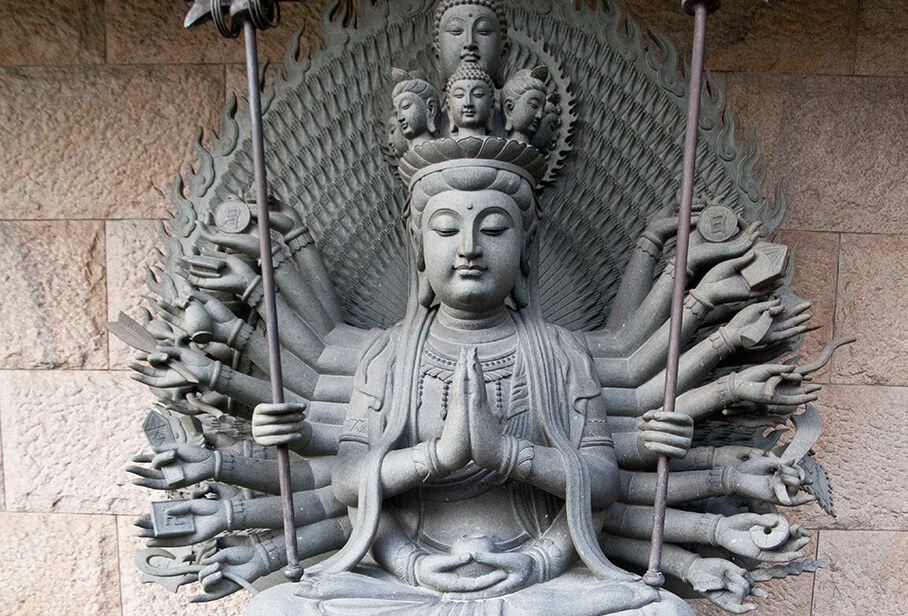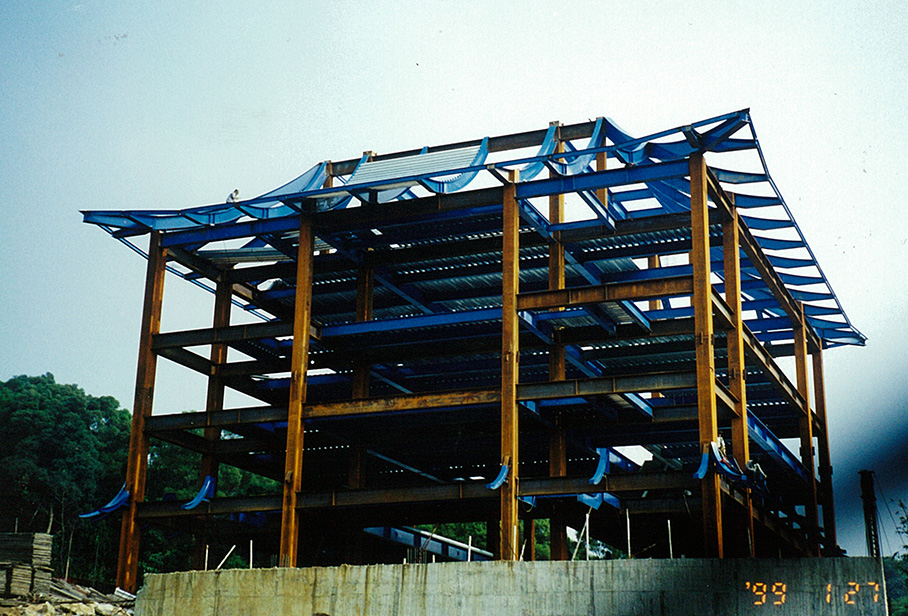To build the Forshang Patriarch Temple was the utmost wish of the 2nd Patriarch, Yuan-Dao Bodhisattva. It is my great fortune to have accomplished this task during my lifetime, fulfilling the 2nd Patriarch’s will. Above all, it was completed by manyof the Forshang disciples collectively.

In 1993, the 3rd Patriarch of Forshang Buddhism, Master Lee Sun-Don, undertook the task entrusted by his respectful teacher, the 2nd Patriarch, for building the Forshang Patriarch Temple (zushimiao祖師廟). The construction began in 1997. Under Master Lee’s design and leadership, a Tang-styled architecture – a sanctuary embodying Forshang dharma heritage – came into existence in Tamsui, New Taipei City of north Taiwan in 2000. In honor of Forshang’s 2nd Patriarch, Yuan-Dao Bodhisattva, the Forshang Patriarch Temple was officially named “Yuan-Dao Guanyin Temple.”
Forshang 佛乘literally means ‘Buddha vehicle,’that is, the vehicle for attaining Buddhahood. BeingForshang Patriarch Temple, whatYuan-Dao Guanyin Templeglorifies and honors is the Buddha that represents the essence of Buddhahood, namely, Da Zi Zai Wang Fo 大自在王佛, which is also the name for Dharma-Body Buddha or dharmakāya法身佛.About 2500 years ago, when Prince Siddhartha Gautama sat meditating under a tree and achieved awakening, becoming Sakyamuni Buddha, he looked up the stars in the east and delivered his first and foremost Buddhist teaching: “Very good, indeed! All beings are in possession of Buddha nature and will attain Buddha fruition eventually.” Da Zi Zai Wang Fo represents exactly what Sakyamuni Buddha means by “Buddha nature” as well as “Buddha fruition.” Each Buddha has his own name which speaks his vows and characteristic virtue, but when it comes to the essence of Buddhahood or the Dharma-Body, they are all the same – namely, Da Zi Zai Wang Fo. Although we are not yet enlightened, we are also Buddha, Buddha of the future. In this sense, when we worship Da Zi Zai Wang Fo, we are not only paying homage to all the Buddhas,but also evoking our yet-to-be enlightened Buddhahood. In other words, Da Zi Zai Wang Fo is where our self and Buddhas are united.
To help the sentient beings get liberation from afflictions on their way to enlightenment, Master Lee has offered various Buddha dharmas, theexpedient means of salvation, for those in need. These dharmas include Blessing Incense (to pray and wish), Glory Lamp (body-mind wellbeing), Grand Divine Oracle (seeking advice from Buddha), the Totemic Energy Nine-Cell Matrix (purification), the Totemic Energy Pyramid (activating one’s potentials), and the like.
The outdoor is designed as a Zen garden, which measures 33,000 ㎡ or so. Herethe temple’s signature Guardian Stone (zhenshanshibao鎮山石寶), inscribed with Master Lee’s calligraphy of the verse from The Lotus Sutra,“nianbiguanyin li念彼觀音力–the power of thinking of Guanyin– is especially eye-catching.As an echo, there are 33 Guanyin stone statues spreading around in the garden, each with its unique compassionate vows and in various manifestation. They bring soothing serenity and ineffable transcendental aura to the sanctuary, and bestow blessing upon those strollingabout.
What is also manifesting, and cannot be dismissed when it comes to the Temple’s establishment, is the Forshang disciples’ effortand contribution, whether by donation or as volunteers, from daily chores to occasional maintenance work, such as paving the lawn, planting the cherry trees, repairing the bridge, and the like. The story of the Temple’s “Forever Courtyard” is one such classic. The Forshang disciples’ religious commitments resonate perfectly withbodhisattvas’selflessness and addfurther harmony and vitality to the temple.
To date, many tourists worldwide have paid a visit to the Temple. It is not only a must-visit tourist site of northern Taiwan, but more importantly, a sanctuary for those looking for inner tranquility and spiritual transcendence.
Indeed, what Yuan-Dao Guanyin represents is more than a parochial site for sightseeing, but sets up an example of what a temple stands for in contemporary secular world. As Master Lee puts it,
The establishment of Yuan-Dao Guanyin Templeis to establish the ultimate foundation wherein all human minds, all human nature, and all Buddhahood take root and develop….
The establishment of Yuan-Dao Guanyin Temple is not just aboutthe energy cultivation of the Forshang Buddhism, but how it develops its dharma scope and delivers its compassionate vows more widely and broadly,
In line with this spirit, a second Forshang sanctuaryhas been under construction since 2013, that is, The Thousand-Hand Thousand-Eye Guanyin Bodhisattva Statue at Tamsui 淡水‧千手觀音–for “Guanyin is also one of the Forshang’s Patriarchs,” said the 2nd Patriarch Yuan-Dao Bodhisattva.
In 2019, this holy Guanyin Statue has earned a GUINNESS WORLD RECORDSTM title as “The Largest Steel Sculpture.” Following the example set up by Yuan-Dao Guanyin Temple, it will be established as a matrix where our compassion is nurtured and reaches out, and where all related sentient beings across time and space converge and get inspired. Ultimately, the ideal of Forshang World will come to realization.
The Buddha worshipped in the main hall is Da Zi Zai Wang Fo 大自在王佛. It isaccompanied by four of the world’s best well-known bodhisattvas, namely Bodhisattva Guanyin 觀音(Avalokiteśvara, signifying the virtue of compassion), Bodhisattva Wenshu文殊 (Mañjuśrī, Bodhisattva of wisdom), Bodhisattva Dizang地藏 (Kṣitigarbha, Bodhisattva of great vow), and Bodhisattva Puxian普賢 (Samantabhadra, Bodhisattva of practice), together with the guardian bodhisattvas of Weituo韋馱 (Skanda) and Qielan伽藍 (Samghārāma).
Da Zi Zai Wang Fo, literally ‘the ultimate Buddha of great freedom,’ refers to the ultimate Dharma-Body Buddha, also known as Mahā Vairocana in Sanskrit. “It is the core of all sentient beings’ intrinsic nature to become Buddha, and the collectivity of every Buddha’s Dharma-Body in terms of Buddhist doctrines and essence,” said the 2nd Patriarch, Yuan-Dao Bodhisattva. This name appears in many scriptures. In the Sutra of the Great Holy Wenshu Bodhisattva’s Buddha Land and Magnificent Virtue大聖文殊師利菩薩佛剎功德莊嚴經, it is said, “In the northeast there is a world named Qian Zhuangyan 千莊嚴, where lives a Buddha called Da Zi Zai WangBuddha大自在王如來…. The sentient beings in this world are peaceful and blissful.” The founder of Chinese Zen Buddhism, Bodhidharma 達摩, also mentioned about it in his “Bloodstream Sermon 血脈論”: “When one’s wisdom is enlightened, one knows the mind – the mind that is called ‘dharma-nature,’ also called ‘liberation,’ a mind that can never be restrained by life, death, or whatsoever. This mind is called Da Zi Zai Wang Buddha大自在王如來.”
According to these sutras, therefore, to chant the Buddha’s name – Na Mo Ben Shi Da Zi Zai Wang Fo南無本師大自在王佛, one not only receives blessing from allthe Buddhas, being peaceful and blissful, but also gets to activate one’s innate Buddhahood that is absolutely free and unbound. With the unity of self and Buddha, one will be empowered with great wisdom, great dignity and purity, and inconceivable fortune.
Forshang’s 2nd Patriarch, Yuan-Dao Bodhisattva, is also honored and worshipped. His statue, placed to the right of the main hall, is an enlarged edition of the one made in August 1997 in commemoration of the 80th anniversary of his birth, four years after he entered nirvana. There are couplets hung on either side of the Statue: “Innate nature is the supreme; the ten greats are in oneness自性華嚴十大一如” and “Myriads of dharmas are perfectly unified; myriads of virtues are beyond sublimity萬法圓通萬德莊嚴.” These are words Yuan-Dao Bodhisattva inscribed on the 3rd Patriarch Sun-Don’s personal copy of The Avataṃsaka Sutra華嚴經, the most grandiose and comprehensive Buddhist scripture. Thecouplets speak not onlythe means to attain Buddha fruition, but also the dharma transmission of Forshang heritage between two patriarchs.
Right to the rear of the temple sits the Thousand-Hand Thousand-Eye Guanyin Bodhisattva. As so named, this bodhisattva possesses 1000 hands representing his multifarious means to help the people and 1000 eyes, shown on each palm of the hands, indicating the wisdom to perceive all sentient beings. He is abodhisattva known for his great compassion and inconceivable power.
To build a temple for Da Zi Zai Wang Fo, the first and foremost is to find the land. But where could it be? Forshang’s 3rd Patriarch Master Lee had made divination about it and the oracle read: “Where is home, where is home? East of the sea and north of the river, the place to become renowned, as a ray of light soaring up high in the sky.” Indeed, the temple is eventually located east of the Taiwan Strait, and north of the Tamsui River.
For land hunting, Master Lee assigned this job to his disciple, Professor Huang Chin-Chun. Professor Huang had looked for the location for three years without any result. So he asked Master Lee for advice and was told, “No hurry, I’ll call you up when the day comes….” In March 1997, the instruction came: “At dawn, you just drive and drive wherever until you get lost, and that is where the temple will be built.” As instructed, Professor Huang drove about, here and there, and finally got into somewhere with weeds taller than himself and found no way out. He saw a farmer plowing, and then got off the car, asking, “which way to Taipei”? Upon asking, he suddenly realized that he was at the moment of “losing himself”; meaning, this was the destination. Professor Huang concluded, “That was a place of nowhere, a desolate wild field. No one would take a look at it. It can only be Buddha’s own choice; Da Zi Zai Wang Fo chooses the place himself.”
The contract was soon signed in a week and the land acquired, but then the challenge followed. Problems arose as the application was sent for building permit. The land was purchased from a construction company who, however, had some legal disputes with the original land owner, and this legal issue made the land purchased illegible for construction. Having spent so much money on a piece of land that could not be used for building, Professor Huang had no tears left to cry. He hastened to seek help from Master Lee, who then said to him: “Buy the surrounding lands as well.” From a secular point of view, this was a risk; one might lose even more. But Master Lee thought in Buddhist terms: “When the space expands, the power it embodies expands in corollary and all related functions will be mobilized in turn.” Remarkably, as Professor Huang was doing as instructed, he got to contact with the original landlord who, upon knowing that the land was purchased for building a temple, immediately provided all documents necessary for the application. The building permit was finally in hand –Thanks to Da Zi Zai Wang Fo!










 , All Rights Reserved.
, All Rights Reserved.